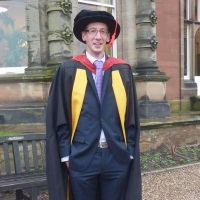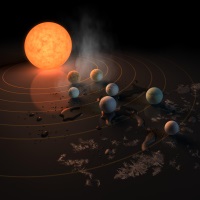Keele alumnus helps NASA discover seven new planets

Keele University Astrophysics graduate Dr Dan Holdsworth recently worked with NASA to observe a new solar system, and helped identify seven earth-sized planets 40 million light years away.
Dan graduated from Keele University in January 2016 with a PhD in Astrophysics. During his studies he worked with Keele’s Wide Angle Search for Planets (WASP) and was introduced to Michael Gillon, the lead researcher and principal investigator of the new exoplanet system called TRAPPIST-1.
In June 2016 Dr Holdsworth was contacted by Dr Gillon to help observe the solar system at the South African Astronomical Observatory, which led to the discovery of seven new planets, of which three are located in a habitable zone and are most likely to have liquid water.
Dr Holdsworth, now a postdoctoral research associate at the University of Central Lancashire, said: “I was asked to observe the host star and monitor its brightness. The brightness of the star dims when the planets pass in front of it, so we can detect how big the planets are and how far they are from the star.
“My PhD played a big role in my research, as did the experience I gained at the Keele Observatory. When the lead author got in touch with me to help observe the star I didn’t realise at the time how big this discovery was going to be and it has only recently sunk in.”
NASA will use the Hubble Space Telescope to screen four of the planets, including the three inside the habitable zone. In 2018 NASA will launch its James Webb Space Telescope which will be able to detect chemical fingerprints of water, methane, oxygen, ozone, and other components of a planet's atmosphere and analyse temperatures and surface pressures.
Dr Holdsworth joined Keele in 2011 and was a Student Trustee of the Keele Postgraduate Association.
 He said: “I was recommended to do my PhD at Keele University and after visiting the nice green campus I applied. I enjoyed my time there and the experience I gained and contacts has set me up for this line of work.”
He said: “I was recommended to do my PhD at Keele University and after visiting the nice green campus I applied. I enjoyed my time there and the experience I gained and contacts has set me up for this line of work.”
His former PhD supervisor Dr Barry Smalley, a senior lecturer at Keele, said: “Dr Holdsworth did some very important observatory work whilst at Keele, and through WASP we have worked closely with TRAPPIST.
“I still keep in touch with Dr Holdsworth and it’s great to see his successful career, he’s done extremely well.”
Image credit: NASA/JPL-Caltech

